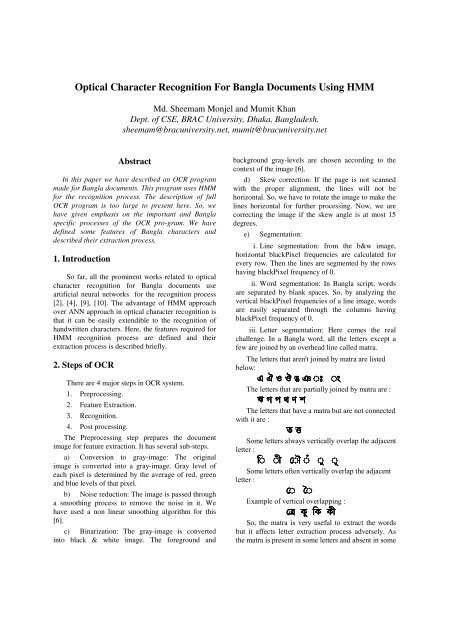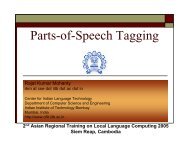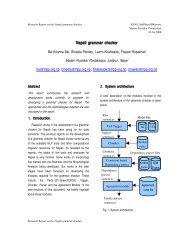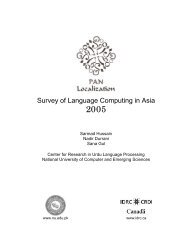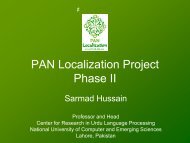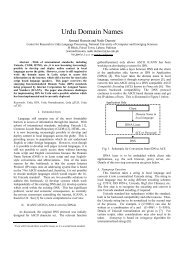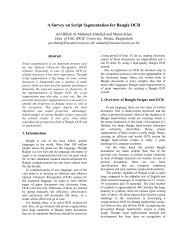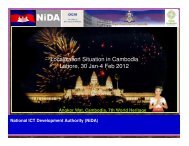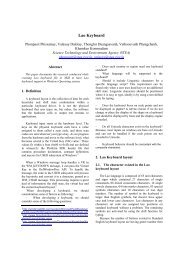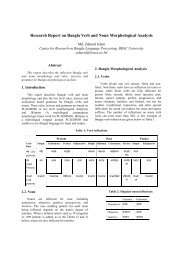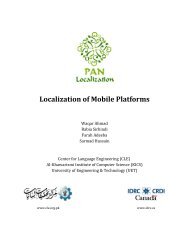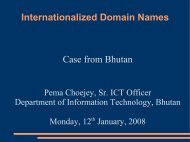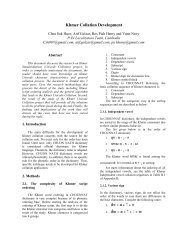Optical Character Recognition For Bangla ... - PAN Localization
Optical Character Recognition For Bangla ... - PAN Localization
Optical Character Recognition For Bangla ... - PAN Localization
You also want an ePaper? Increase the reach of your titles
YUMPU automatically turns print PDFs into web optimized ePapers that Google loves.
<strong>Optical</strong> <strong>Character</strong> <strong>Recognition</strong> <strong>For</strong> <strong>Bangla</strong> Documents Using HMM<br />
Md. Sheemam Monjel and Mumit Khan<br />
Dept. of CSE, BRAC University, Dhaka, <strong>Bangla</strong>desh.<br />
sheemam@bracuniversity.net, mumit@bracuniversity.net<br />
Abstract<br />
In this paper we have described an OCR program<br />
made for <strong>Bangla</strong> documents. This program uses HMM<br />
for the recognition process. The description of full<br />
OCR program is too large to present here. So, we<br />
have given emphasis on the important and <strong>Bangla</strong><br />
specific processes of the OCR pro-gram. We have<br />
defined some features of <strong>Bangla</strong> characters and<br />
described their extraction process.<br />
1. Introduction<br />
So far, all the prominent works related to optical<br />
character recognition for <strong>Bangla</strong> documents use<br />
artificial neural networks for the recognition process<br />
[2], [4], [9], [10]. The advantage of HMM approach<br />
over ANN approach in optical character recognition is<br />
that it can be easily extendible to the recognition of<br />
handwritten characters. Here, the features required for<br />
HMM recognition process are defined and their<br />
extraction process is described briefly.<br />
2. Steps of OCR<br />
There are 4 major steps in OCR system.<br />
1. Preprocessing.<br />
2. Feature Extraction.<br />
3. <strong>Recognition</strong>.<br />
4. Post processing.<br />
The Preprocessing step prepares the document<br />
image for feature extraction. It has several sub-steps.<br />
a) Conversion to gray-image: The original<br />
image is converted into a gray-image. Gray level of<br />
each pixel is determined by the average of red, green<br />
and blue levels of that pixel.<br />
b) Noise reduction: The image is passed through<br />
a smoothing process to remove the noise in it. We<br />
have used a non linear smoothing algorithm for this<br />
[6].<br />
c) Binarization: The gray-image is converted<br />
into black & white image. The foreground and<br />
background gray-levels are chosen according to the<br />
context of the image [6].<br />
d) Skew correction: If the page is not scanned<br />
with the proper alignment, the lines will not be<br />
horizontal. So, we have to rotate the image to make the<br />
lines horizontal for further processing. Now, we are<br />
correcting the image if the skew angle is at most 15<br />
degrees.<br />
e) Segmentation:<br />
i. Line segmentation: from the b&w image,<br />
horizontal blackPixel frequencies are calculated for<br />
every row. Then the lines are segmented by the rows<br />
having blackPixel frequency of 0.<br />
ii. Word segmentation: In <strong>Bangla</strong> script, words<br />
are separated by blank spaces. So, by analyzing the<br />
vertical blackPixel frequencies of a line image, words<br />
are easily separated through the columns having<br />
blackPixel frequency of 0.<br />
iii. Letter segmentation: Here comes the real<br />
challenge. In a <strong>Bangla</strong> word, all the letters except a<br />
few are joined by an overhead line called matra.<br />
The letters that aren't joined by matra are listed<br />
below:<br />
e o ◌ ◌<br />
The letters that are partially joined by matra are :<br />
ш<br />
The letters that have a matra but are not connected<br />
with it are :<br />
t<br />
Some letters always vertically overlap the adjacent<br />
letter :<br />
◌ ◌ ◌ ◌ ◌ ◌<br />
Some letters often vertically overlap the adjacent<br />
letter :<br />
◌ ◌<br />
Example of vertical overlapping :<br />
t к к к<br />
So, the matra is very useful to extract the words<br />
but it affects letter extraction process adversely. As<br />
the matra is present in some letters and absent in some
others, removing the matra altogether may cut some<br />
portion of letters. Sometimes removing the matra<br />
causes some letters to divide into pieces. So, we are<br />
preserving the matra as it is and analyze the word<br />
image avoiding the matra region for letter<br />
segmentation. The first step is to determine the matra.<br />
It is the horizontal line whose blackPixel frequency is<br />
highest among all the rows of a segmented line of<br />
script. So, the vertical location of the matra is<br />
determined during line segmentation. Middle region<br />
of a line is bounded by the matra and a horizontal line<br />
whose distance from the bottom limit of the line is<br />
equal to the distance between the matra and the upper<br />
limit of the line. The bottom 5/6 of this middle region<br />
is analyzed to separate the letters vertically. Vertical<br />
blackPixel frequencies are determined in this region<br />
and the columns having blackPixel frequencies of 0<br />
separates the letters. In this segmentation process, the<br />
letters that vertically overlap the adjacent character<br />
outside the middle region are cut into 2 pieces. These<br />
pieces are combined together in the post processing<br />
step that comes after the recognition step.<br />
f) Skeletization: The separated letters are<br />
thinned to have lines of only one pixel width [11].<br />
g) Component extraction: The connected<br />
components are separated.<br />
After the 7 th step, we get the skeletized<br />
components of characters. Then features are extracted<br />
from the components. These features are used for<br />
recognition.<br />
<strong>For</strong> using HMM, we need a sequence of objects to<br />
traverse through the state sequence of HMM. So, we<br />
have to shape the features into a sequence of objects.<br />
Hence, for each character component, we are making a<br />
tree of features and finally the prefix notation of the<br />
tree is applied to the HMM. In the tree, the number of<br />
child of a node is not fixed. So, we are using childsibling<br />
approach to make the tree. Hence the prefix<br />
notation of the tree will contain nodes in the order:<br />
root, prefix notation of the tree rooted at its child,<br />
prefix notation of the trees rooted at the child’s<br />
siblings from left to right order.<br />
3. Features<br />
Features are the lines of the skeleton of character<br />
components and the points joining the lines.<br />
4. Data Structure<br />
A tree data structure is used for storing the feature<br />
elements. Each node of the tree represents either a line<br />
or a joining point. Suppose a line L1 meets other two<br />
lines (L2, L3 ) at a point. Then the point will be child<br />
of L1, L2 will be sibling of the point and L3 will be<br />
sibling of L2. The directions of lines are classified into<br />
8 main categories and they are numbered as shown in<br />
Figure 1.<br />
Figure 1: Directions of lines<br />
We use an array dir[][]={{1,2,3},{0,-<br />
1,4},{7,6,5}} to hold the direction numbers. The<br />
direction of a line from a point P1 to an adjacent point<br />
P2 is retrieved readily from the array element dir[P2.x-<br />
P1.x+1][P2.y-P1.y+1]. Two adjacent lines are unified<br />
whenever the difference between their directions is 45<br />
degrees. So, unified lines have two directions. The<br />
data structure for lines and joining points are as<br />
follows.<br />
class imageComponent{}<br />
class joiningPoint extends imageComponent<br />
{<br />
}<br />
int lineCount;<br />
line sibling;<br />
joiningPoint(int n){lineCount = n;}<br />
boolean equals(joiningPoint p)<br />
{return lineCount == p.lineCount;}<br />
class line extends imageComponent<br />
{<br />
int direction1,direction2;<br />
Point start;<br />
boolean isObsolete;<br />
joiningPoint child;<br />
line sibling;<br />
line(Point p){start = p; direction1=direction2=-1;}<br />
void setEndPoint(Point p)<br />
{<br />
isObsolete = (start.x==p.x && start.y==p.y);
}<br />
if(!isObsolete)<br />
{<br />
}<br />
int max = dir1>dir2?dir1:dir2;<br />
int min = dir1
Finally, when the endpoint of a line is set, the line<br />
is marked as obsolete if its endpoint is same as the<br />
starting point. These obsolete lines are deleted from<br />
the feature tree.<br />
Figure 2: Lines of different directions<br />
Line 2(a): direction1 = East, direction2 = South-East<br />
Line 2(b): direction1 = East, direction2 = Nil<br />
Line 2(c): direction1 = South, direction2 = Nil<br />
Line 2(d): direction1 = South-East, direction2 = Nil<br />
Line 2(e): direction1 = South-East, direction2 = South<br />
6. An example<br />
Figure 4: The feature tree corresponding to the<br />
letter of Figure 3. A circle denotes line and a<br />
rectangle denotes joining point.<br />
If we represent line by L(dir1,dir2), then<br />
line1 = L(6,5)<br />
line2 = L(4,3)<br />
line3 = L(3,2)<br />
line4 = L(4,-1)<br />
line5 = L(5,4)<br />
If we represent joining Point by P(siblingCount),<br />
then<br />
point 'a' = P(1)<br />
point 'b' = P(2)<br />
point 'c' = P(1)<br />
Now if we express the tree in prefix notation, we<br />
will get<br />
L(6,5) P(1) L(4,3) P(2) L(3,2) P(1) L(5,6) L(4,-1)<br />
This representation is used in HMM for recognition.<br />
Figure 3: A <strong>Bangla</strong> letter<br />
(a) the letter skeleton (b) corresponding bitmap<br />
7. <strong>Recognition</strong><br />
Once the sequence of objects for the letter<br />
components are available, it is very easy to train the<br />
HMM and use it for recognition.<br />
8. HMM<br />
Hidden Markov Models (HMMs) are used for<br />
both online and offline character recognition systems<br />
for different scripts around the world [7],[8]. A<br />
Markov chain or process is a sequence of events,<br />
usually called states, the probability of each of which<br />
is dependent only on the event immediately preceding
it. An HMM represents stochastic sequences as<br />
Markov chains where the states are not directly<br />
observed, but are associated with a probability density<br />
function (pdf). The generation of a random sequence is<br />
then the result of a random walk in the chain (i.e. the<br />
browsing of a random sequence of states Q = {q 1, …,<br />
q k }) and of a draw (called an emission) at each visit of<br />
a state. The sequence of states, which is the quantity of<br />
interest in most of the pattern recognition problems,<br />
can be observed only through the stochastic processes<br />
defined into each state (i.e. one must know the<br />
parameters of the pdfs of each state before being able<br />
to associate a sequence of states Q = {q1, …, q k } to a<br />
sequence of observations X = {x1, …, x k }). The true<br />
sequence of states is therefore hidden by a first layer of<br />
stochastic processes. A Hidden Markov Model is<br />
defined by specifying 5 things :<br />
i. Q = the set of states = {q 1 , q 2 , …, q n }<br />
ii. V = the output alphabet = {v 1 , v 2 , …, v m }<br />
iii. π(i) = probability of being in state q i at time t<br />
= 0 (i.e., in initial states)<br />
iv. A = transition probabilities = {a i,j }, where a i,j<br />
= Pr[entering state q j at time t + 1 | in state q i at time<br />
t].<br />
v. B = output probabilites = {b j (k)}, where b j (k)<br />
= Pr [producing v k at time t | in state q j at time t].<br />
The recognition process measures the<br />
probabilities of generating the object sequence got<br />
from the feature extraction of the component under<br />
consideration from the HMMs of different letter<br />
components . The highest among these probabilities<br />
decides the letter component with the closest match.<br />
The process of calculating these probabilities is<br />
described below.<br />
Let the object sequence corresponding to a letter<br />
component be X = {x 1 , x 2 , …, x n }. and the HMM<br />
corresponding to a template letter component be H.<br />
Now, probability of generation of X from H is<br />
p(X|H) = Σ p(X,Q | H) , for every possible Q.<br />
[Q is state sequence {q 1 , q 2 , …, q T }].<br />
Now, according to Bayes theorem,<br />
p(X,Q | H) = p(X,Q | H) . p(Q | H)<br />
The terms of right hand side are calculated by:<br />
p(X,Q | H) = Π p(x i | q i ,H) , i = 1 to T<br />
= b 1 (x 1 ).b 2 (x 2 )…b T (x T ).<br />
p(Q | H) = Π a i,i+1 , i = 1 to T-1<br />
= a 1,2 .a 2,3 …a T-1,T<br />
While comparing the lines in HMM, only the<br />
directions are checked for matching. And in the case of<br />
comparing the joiningPoints, the no. of lines<br />
originating from it is considered.<br />
9. Postprocessing<br />
Now, after the recognition process, some post<br />
processing is necessary. It has two steps.<br />
9.1. Constructing the letters from components.<br />
In the segmentation process, some letters are cut<br />
into pieces because the overlap their adjacent letters.<br />
So, after recognition, the pieces should be joined<br />
together to form the original letter. Consider the<br />
following example.<br />
Figure 5 : Extraction of letters from a word<br />
In this example, a word is separated into 5 parts.<br />
But in the 4 th part, there are two components. So, after<br />
the recognition process, we will get 6 objects :<br />
1. consonant letter ssa ()<br />
2. vowel sign A-kar (◌ )<br />
3. vowel sign A-kar (◌ )<br />
4. upper portion of vowel sign I-kar ( ◌ ).<br />
5. consonant letter dha ()<br />
6. consonant letter ta ()<br />
Now, we have to unify the object3 and object4 to<br />
make vowel sign I-kar (◌ ).<br />
9.2. Rearranging the letters.<br />
Sometimes, the letters of a word are not stored (in<br />
files) in the order they appear on the screen after<br />
rendering. In Unicode standard, dependent vowels or<br />
vowel signs come after the consonant associated with<br />
it. But on the screen as well as in the printed<br />
documents, the vowel signs may appear on left, down<br />
or right side of the consonant Vowel signs may also
wrap the consonant up from both sides. So, after a<br />
word is recognized, the letters are rearranged<br />
according to Unicode standard[12]. <strong>For</strong> example,<br />
when we will get e-kar (◌ ) and a-kar (◌ ) around a<br />
character, we should make it o-kar (◌ ). The same<br />
rule should be applied to make ou-kar ( ◌ ).<br />
10. Conclusion and future work<br />
There are still some problems regarding the letter<br />
segmentation. Sometimes adjacent letters are joined to<br />
each other in such a way that they cannot be vertically<br />
separated in the normal vertical histogram approach.<br />
Some papers are avail-able describing various ways to<br />
handle the problem of segmentation of joined<br />
characters [1], [3], [5]. Our future work in this regard<br />
will be analyzing the features of joined letters and<br />
incorporating a better way of segmentation.<br />
11. Acknowledgement<br />
This work has been partially supported through<br />
<strong>PAN</strong> <strong>Localization</strong> Project (www.<strong>PAN</strong>L10n.net) grant<br />
from the International Development Research Center,<br />
Ottawa, Canada, ad-ministered through Center for<br />
Research in Urdu Language Processing, National<br />
University of Computer and Emerging Sciences,<br />
Pakistan.<br />
12. References<br />
background and fore-ground analysis”, Proc. 15th<br />
ICPR, 2000, pp. 598-601.<br />
[6] E. Gose, R. JohansonBaugh, S. Jost, Pattern<br />
<strong>Recognition</strong> and Image Analysis, Prentice Hall of<br />
India, New Delhi 2002.<br />
[7] R. Nopsuwanchai, D. Povey, “Discriminative<br />
Training for HMM-Based Offline Handwritten<br />
<strong>Character</strong> <strong>Recognition</strong>”, Proc. 7th ICDAR, 2003.<br />
[8] H. Nishimura, T. Timikawa, “Off-line <strong>Character</strong><br />
<strong>Recognition</strong> using On-line <strong>Character</strong> Writing<br />
Information”, Proc. 7th ICDAR, 2003.<br />
[9] M. M. Rahman, A. N. M. E. Rafiq, S. Rahman,<br />
“Online Handwritten <strong>Bangla</strong> Numeral <strong>Recognition</strong> by<br />
Grid Method”, Proc. 2nd ICECE, 2002.<br />
[10] S. H. Shaikot, F. Kawsar, M. S. Saikat, “Bengali<br />
Digit <strong>Recognition</strong> System using 3-layer<br />
Backpropagation Neural Network”, 6th ICCIT, 2003,<br />
pp.327-331.<br />
[11] C. Y. Suen, T. Y. Zhang, “A Fast Parallel<br />
Algorithm for Thinning Digital Patterns”,<br />
Communications of the ACM, Vol.27, March 1984.<br />
[12] www.unicode.org<br />
[1] A. Belaid, C. Choisy, U. Pal, “Water Reservoir<br />
Based Approach for Touching Numeral<br />
Segmentation”, Proc. 6th ICDAR, 2001.<br />
[2] B. B. Chaudhury, U. Pal, “OCR in <strong>Bangla</strong> : An<br />
Indo-<strong>Bangla</strong>deshi Language”, Proc. IEEE, 2001, pp.<br />
269-273.<br />
[3] B.B. Chaudhury, U. Garain, “Segmentation of<br />
Touching <strong>Character</strong>s in Printed Devnagari and <strong>Bangla</strong><br />
Scripts Using Fuzzy Multifactorial Analysis”, IEEE<br />
Transactions on Systems, Man and Cybernetics-Part<br />
C: Applications and Reviews, Vol. 32, No.4, Nov,<br />
2002.<br />
[4] S. Chowdhury, S. Dutta, G. Parthasarathy, “On<br />
<strong>Recognition</strong> of Bengali Numerals with Back<br />
Propagation Learning”, Proc. IEEE, 1992, pp. 94-99.<br />
[5] Y. K. Chen, J. F. Wang, “Segmentation of<br />
handwritten connected numeral string using


